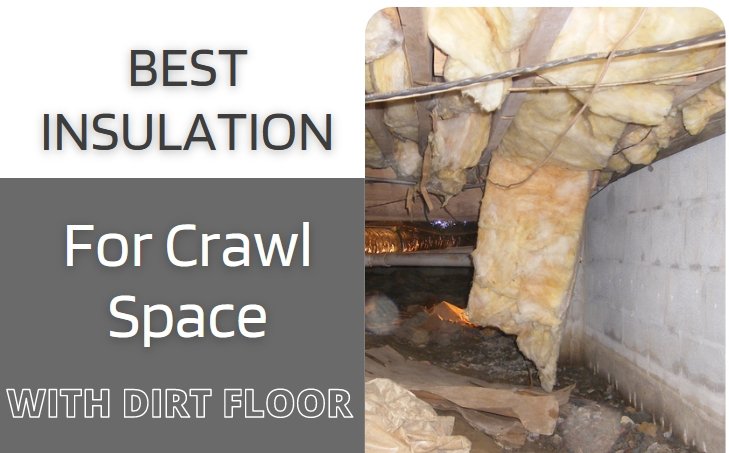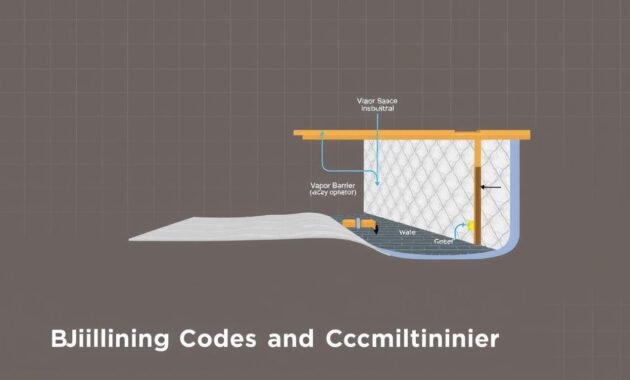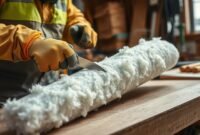Are you tired of cold floors and high energy bills? Uninsulated crawl spaces with dirt floors can cause a lot of problems. They can lead to mold, drafts, and waste energy.
I’ve been there too, dealing with an uninsulated crawl space. That’s why I’m sharing this guide to help you. You’ll learn how to pick the right insulation and install it correctly. This will make your crawl space energy-efficient and comfortable.
Understanding Crawl Space Basics and Their Impact on Home Efficiency
Crawl spaces are key in home construction, though often overlooked. They are shallow areas under your home. They help with plumbing, electrical lines, and structural parts, keeping your home running well.

Crawl spaces are different from full basements. Basements are better insulated, but crawl spaces are more exposed. This makes them more prone to problems.
The Critical Role of Crawl Spaces in Home Structure
Crawl spaces are more than empty spaces. They act as a buffer zone. This affects your home’s:
- Structural integrity
- Indoor air quality
- Energy efficiency
- Moisture management
Common Problems with Uninsulated Crawl Spaces
Uninsulated crawl spaces can cause big issues. Cold floors are a common sign. Without insulation, mold grows, and structural damage risks increase.
Read also: Benefits of Insulating Crawl Space With Dirt Floor
Impact on Energy Bills and Home Comfort
An unaddressed crawl space hurts your home’s energy efficiency. Without insulation, your heating and cooling systems work too hard. This raises your utility bills. Properly managing your crawl space makes your home more comfortable and energy-efficient.
Why Traditional Fiberglass Insulation Fails in Crawl Spaces
Fiberglass batt insulation can be a big problem in crawl spaces. It seems harmless but often causes more issues than it solves. This is true for the unique conditions found in crawl spaces.
Fiberglass batts soak up moisture from the ground and air. This makes them perfect for mold and mildew to grow. These problems can harm your home’s air and structure.
- Moisture absorption reduces insulation effectiveness
- Creates ideal conditions for mold and mildew growth
- Loses thermal resistance when wet
- Fails to provide adequate air sealing
Fiberglass batts have more issues than just moisture. They can sag, compress, and leave gaps. In a crawl space’s damp environment, they can’t keep their protective qualities.
Using fiberglass batts in crawl spaces can lead to big problems. They can attract pests, lose their insulating power, and cause structural damage. Homeowners often face these unexpected issues.
Best Insulation for Crawl Space With Dirt Floor
Choosing the right insulation for a crawl space with a dirt floor is key. It affects your home’s energy use and keeps moisture out. Let’s explore the top insulation options for these challenging spaces.
Closed-Cell Spray Foam Benefits
Closed-cell spray foam is a top choice for crawl spaces with dirt floors. It seals air tight and protects against moisture. Applied to walls and floors, it offers many benefits:
- Superior moisture barrier for dirt floor surfaces
- High R-value per inch of thickness
- Prevents air infiltration and reduces energy loss
- Resists mold and moisture damage
Rigid Foam Board Applications
Rigid foam boards are another solid option for crawl spaces with dirt floors. Panels like XPS and polyisocyanurate are great for insulation and moisture control. They’re durable and effective.
- High insulation value for crawl space dirt areas
- Lightweight and easy to install
- Resistant to moisture and pests
Blanket Insulation Solutions
Blanket insulation can work in some crawl spaces, but it’s not ideal for dirt floors. Fiberglass or mineral wool batts might be used. But, they need careful installation and extra moisture protection.
When picking insulation for your crawl space, think about moisture levels, temperature, and your home’s needs. A professional can help choose the best insulation for your space.
Read also: Where Not to Use Spray Foam Insulation ?
The Critical Role of Moisture Control in Crawl Space Insulation

Keeping your home dry is key when you have a crawl space dirt floor. Too much moisture can cause mold and mildew. This can harm your home’s structure and air quality. I’ve seen many homeowners deal with moisture problems that could have been avoided with the right moisture control.
Crawl space dirt floors are always at risk of moisture. Water vapor from the ground can make your crawl space damp. This can lead to mold and damage. A good moisture control system is essential to protect your home.
- Prevents mold and mildew growth
- Reduces humidity levels in your home
- Protects structural integrity
- Improves overall indoor air quality
Vapor barriers are key in managing moisture. They act as a barrier between the crawl space and your foundation. By stopping moisture, they prevent damage. The right vapor barrier can greatly reduce mold and mildew risks.
Choosing the right moisture control depends on your crawl space’s conditions. Things like humidity, soil, and home design matter. A professional can help you find the best solution to keep your home dry and safe.
Proper Installation Techniques for Crawl Space Insulation
Insulating a crawl space needs careful planning and precision. The right steps can make your home more energy-efficient and protect it from moisture. I’ll show you how to do it right.
Before starting, thorough preparation is essential. A good insulation job begins with a clean and ready surface.
Surface Preparation Essentials
- Clean the entire crawl space thoroughly
- Remove all debris, standing water, and organic materials
- Inspect for signs of moisture, mold, or pest infestation
- Repair any structural damage or wood rot
- Ensure proper ventilation and drainage
Best Installation Practices
For insulating crawl spaces, follow these expert tips:
- Measure the space accurately before buying materials
- Choose the right insulation for your environment
- Use open-cell spray foam for flexible, breathable coverage
- Seal all gaps and air leak points
- Keep a proper air gap between insulation and foundation walls
Installation Mistakes to Avoid
| Common Mistake | Potential Consequence |
|---|---|
| Incomplete coverage | Reduced thermal efficiency |
| Ignoring moisture barriers | Potential mold growth |
| Improper sealing | Air leaks and energy loss |
| Skipping professional assessment | Ineffective insulation strategy |
Professional installation keeps your crawl space safe, energy-efficient, and dry. Spending time on proper preparation and installation saves money and prevents future problems.
Comparing R-Values and Insulation Performance
Understanding R-values is key when choosing crawl space insulation. R-value shows how well insulation stops heat from moving. Not all insulation works the same, thanks to crawl space challenges.
Different insulation types for crawl spaces have different R-values:
- Open-cell spray foam: R-3.6 to R-4.3 per inch
- Closed-cell spray foam: R-6 to R-7 per inch
- Rigid foam board: R-4 to R-6 per inch
- Fiberglass batts: R-2.2 to R-4.3 per inch
Don’t just look at R-values when picking insulation. Moisture resistance, air-sealing, and durability matter too. Open-cell spray foam, for example, seals air well, not just stops heat.
The lowest R-value isn’t always bad. What’s important is insulation that controls moisture, stops air leaks, and keeps temperature steady. Spray foam often beats traditional materials by blocking environmental issues.
When picking insulation for your crawl space, think about the whole system, not just R-values. Your local climate, home design, and moisture levels will guide the best choice.
Vapor Barriers and Their Essential Role
Installing the right vapor barrier is key when you have a crawl space dirt floor. Many homeowners don’t realize how important moisture control is. A good vapor barrier stops ground moisture from harming your home’s foundation and insulation.
Vapor barriers act as a shield against moisture in your crawl space. They help keep humidity low, stop mold, and make your home more energy-efficient. This is based on my experience with crawl space insulation.
Types of Vapor Barriers
Not all vapor barriers are the same. Here are the main types:
- 6-mil polyethylene sheeting (most common)
- Reinforced plastic barriers
- Specialized crawl space encapsulation materials
- Foil-faced vapor barriers
Installation Guidelines
Here’s how to install a vapor barrier in a crawl space with dirt:
- Clean and level the crawl space ground
- Remove any sharp objects or debris
- Ensure at least 6-inch overlaps between sheets
- Extend sheeting 6-12 inches up foundation walls
- Seal all seams with specialized tape
Proper installation is vital for a good moisture barrier. I suggest getting a professional to check for full coverage and protection.
Wall Insulation Strategies for Crawl Spaces
Insulating crawl space walls is key to a cozy home. It boosts energy efficiency and fights moisture. My experience shows that the right insulation makes a big difference in comfort and performance.
Spray foam is a top pick for wall insulation. It’s a strong air and moisture barrier. Spray foam seals gaps and cracks better than other materials.
- Closed-cell spray foam provides the highest R-value per inch
- Creates an excellent moisture barrier
- Prevents air leakage and drafts
- Adds structural strength to crawl space walls
Rigid foam panels are also great for insulation. They have many benefits:
- Easy to install
- Provide consistent insulation coverage
- Resistant to moisture and mold
- Can be mechanically fastened to wall surfaces
For best results, use a mix of insulation methods. I suggest combining wall insulation with vapor barriers and floor insulation. Quality insulation protects your home, saves energy, and cuts down on heating and cooling costs.
Cost Analysis and Return on Investment
At first glance, crawl space insulation might seem pricey. But the long-term gains are much greater than the upfront costs. Homeowners can save money and boost their home’s energy use.
The cost to insulate a crawl space varies based on several factors. Here’s a look at typical costs and savings:
- Material costs for crawl space insulation range from $1.50 to $3.50 per square foot
- Professional installation can add $2 to $4 per square foot
- Total project costs typically run between $1,500 and $5,000
| Insulation Type | Cost per Sq Ft | Energy Savings |
|---|---|---|
| Closed-Cell Spray Foam | $2.50 – $3.50 | Up to 20% on heating/cooling |
| Rigid Foam Board | $1.50 – $2.50 | Up to 15% on energy bills |
| Fiberglass Batts | $1.00 – $1.50 | Up to 10% on energy costs |
The payoff for crawl space insulation is big. It cuts down on air leaks and boosts your home’s energy use. Most homeowners get their money back in 3-5 years from lower energy bills.
But insulation does more than save cash. It also guards against moisture damage, enhances air quality, and raises your home’s value. Think of it as a wise investment in your home’s comfort and efficiency.
Building Codes and Compliance Requirements

When planning insulation for your crawl space, knowing local building codes is key. These rules ensure safety, energy savings, and the right installation of your insulation project.
Different parts of the United States have unique insulation needs for crawl spaces. The International Residential Code (IRC) sets guidelines that change based on where you are. Here are the main things you need to know:
- Minimum R-value requirements based on geographic region
- Ventilation standards for crawl spaces
- Moisture control regulations
- Inspection and permitting processes
Most places have specific R-value standards for crawl space insulation. In colder areas, you’ll need higher R-values than in warmer ones. R-values usually range from R-10 to R-20, depending on your location.
Before starting your insulation project, take these steps:
- Contact your local building department
- Obtain necessary permits
- Schedule required inspections
- Verify compliance with local building codes
Professional contractors who know local rules can guide you. Some areas might have extra rules or specific ways to install insulation in crawl spaces.
Conclusion
Insulating a crawl space with a dirt floor is more than a home improvement. It’s an investment in your property’s health and efficiency. We’ve looked at why insulating this area is key for your home’s comfort and energy use.
The right insulation for a crawl space with a dirt floor varies. Depending on your home, options like closed-cell spray foam or rigid foam board can be great. I’ve found that good insulation does more than save on energy bills. It also keeps moisture out, protects your home’s structure, and keeps the temperature steady.
While some might try to do it themselves, I suggest getting help from insulation pros. They can check your crawl space, suggest the best insulation, and make sure it’s installed right. Getting professional help can save you money and trouble in the long run, keeping your home safe from moisture and energy waste.
A well-insulated crawl space is like a silent guardian for your home. By understanding and using the right insulation, you’re not just making your home better. You’re also protecting your home’s future, one square foot at a time.


